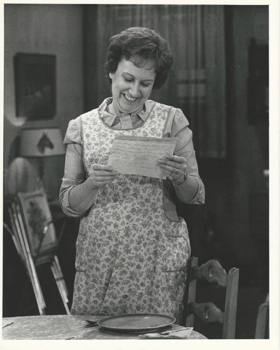National Museum of American History Receives Jean Stapleton Donations

The Smithsonian's National Museum of American History recently received a donation from the family of actress Jean Stapleton (1923-2013) that showcases her career. The objects range from the apron she wore while playing Edith Bunker in All in the Family, a crew jacket from the set of All in the Family, a selection of the awards that she won throughout her career, costumes and props from her career in theater and TV, memorabilia related to her work as a women's rights activist and papers reflecting her dedication Eleanor Roosevelt's legacy.
As a character actress, Stapleton spent a lifetime in the theater, beginning in 1941 at the American Apprentice Theater in New York City and spanning to 2002 in the original production of The Carpet Bagger's Children at Lincoln Center Theater. In the 1970s, she became widely known for her portrayal of Edith Bunker on the groundbreaking TV series All in the Family. Though this exposure gave her an international audience in TV and film, she always returned to the theater.
The donation includes photos, programs, scripts, clippings and memorabilia starting in the '40s from Stapleton's early work in summer stock, including the Greenwood Playhouse in Maine, the Chase Barn Playhouse in New Hampshire, the Falmouth Playhouse in Cape Cod and the Cecilwood Theatre in Fishkill, N.Y. In 1948, she played Myrtle Mae in her first national tour of Harvey, and in 1953, she made her Broadway debut in In the Summer House. Her early Broadway work is represented by opening-night gifts and telegrams from Rogers and Hammerstein, Barbra Streisand and Judy Holliday and others for productions such as Rhinoceros, Juno, Bells Are Ringing, Damn Yankees and Funny Girl. Programs and photos represent the 81 productions Stapleton performed in at her husband's, William H. Putch, Totem Pole Playhouse in Pennsylvania where she never missed a season in 25 years beginning in 1958.
The '70s brought TV exposure, and the collection includes material related to All in The Family. There also is memorabilia related to her work in the late '70s and early '80s in the women's movement, for which she became a symbol of emergent feminism in American popular culture. In 1983, she began a project that would link her with Eleanor Roosevelt in many different projects for the next 18 years, including a TV movie for which she was nominated for an Emmy, and a one-woman show, Eleanor: Her Secret Journey. Her papers include photos and items related to this work along with her study and contribution to the legacy of Eleanor Roosevelt and Val Kill. In 1985, she began a seven-year national tour of a one-woman operetta based on Ruth Drapers' The Italian Lesson and Bon Appetite! an original work where she plays Julia Child. Her costume from The Italian Lesson is part of the donation.
"These objects tell the story of a lifelong career in the entertainment industry, from the small stage of the Maine Summer Stock Company to Broadway and, most memorably, to her character on one of the most groundbreaking shows on television" said Ryan Lintelman, curator of entertainment at the museum.
In 2002, Stapleton was inducted into the American Theatre Hall of Fame and the Television Hall of Fame for her contributions to the arts. The donation to the museum reflects her long career and contributions to the history of theater, television and movies.
There are no immediate plans to display the new objects, but an exhibition is in development that will explore American culture and will draw on the museum's theater, music, sports and entertainment collections. That exhibition is expected to open in 2020.
Among the more 3 million objects in the National Collections are thousands of objects that illustrate the history of entertainment. The National Entertainment Collection is diverse and distinctive. From props and sets to costumes and scripts-the collection is preserved on behalf of the American people to educate and inspire.
Through incomparable collections, rigorous research and dynamic public outreach, the National Museum of American History explores the infinite richness and complexity of American history. It helps people understand the past in order to make sense of the present and shape a more humane future. The museum is located on Constitution Avenue N.W., between 12th and 14th Streets, and is open daily from 10 a.m. to 5:30 p.m. (closed Dec. 25). Admission is free. For more information, visit http://americanhistory.si.edu. For Smithsonian information, the public may call (202) 633-1000.

Videos

